Genome-Wide Identification and Functional Analysis of the bZIP Transcription Factor Family in Rice Bakanae Disease Pathogen, Fusarium fujikuroi
Abstract
1. Introduction
2. Results
2.1. Identification of the FfbZIP Transcription Factor Family from F. fusarium
2.2. Conserved Domain and Structure of FfbZIP Protein
2.3. Intron Distribution Analysis of FfbZIP Gene
2.4. Phylogenetic Analysis of FfbZIP Proteins
2.5. Construction and Identification of FfbZIP Deletion Mutants
2.6. Phenotypic Observation of FfbZIP Deletion Mutants
2.6.1. Fungi Morphology Observation
2.6.2. Oxidative Stress Experiment
2.6.3. Osmotic Stress Experiment
2.6.4. Cell Wall Selection Pressure Experiment
2.6.5. Cellulose Utilization Experiment
2.6.6. Cellophane Penetration Experiment
2.7. Pathogenicity Assay of FfbZIP Deletion Mutants
3. Discussion
4. Materials and Methods
4.1. Identification of bZIP Transcription Factors in F. fujikuroi
4.2. Structural Analysis of bZIP Transcription Factors
4.3. Phylogenetic Analysis of bZIP Transcription Factors
4.4. Generation of FfbZIP Gene Deletion Mutants
4.5. Phenotype Assays
- (a)
- Strain growth rate observation. The fungi block with 7 mm diameter was cut from the outer periphery of the wild-type strain and deletion mutants cultured for 5 days. We cultured these fungi blocks in PDA (Biological Technology Co., Shanghai, China Zhaorui) medium with natural light at 28 °C, measured the diameter of the strains every 24 h for 7 days and observed the morphological characteristics of the strains (color, shape, growth of aerial hyphae, etc.). Analysis of variance (ANOVA) was used to determine the growth between wild-type and mutant strains (Statistical Product Service Solutions (SPSS)). Each strain was inoculated in three replicates [67].
- (b)
- Stress sensitivity test. Oxidative stress experiment: the volume percentages concentration of 0.1%, 0.25%, and 0.5% of H2O2 (Aladdin Biochemical Technology Co., Ltd., Shanghai, China) were added to the PDA medium to prepare H2O2 PDA mediums with different concentrations; osmotic stress experiment: different concentrations of NaCl (National Pharmaceutical Group Chemical Reagent Co., Ltd., Beijing, China) were added to the PDA medium to prepare PDA mediums containing NaCl concentrations of 1 mol·L−1 and 2 mol·L−1; cell wall selection pressure experiment: sorbitol PDA mediums with 1 mol·L−1 and 2 mol·L−1 concentrations were prepared by adding sorbitol; cellulose utilization experiment: cellulose Congo red mediums (Zhaorui Biological Technology Co., Shanghai, China) were used. The 7 mm diameter fungi blocks of F. fujikuroi cultured for 5 days were transferred in the center of the each medium. They were cultured in a 28 °C incubator for 5 days, we observed and measured the strain size and took pictures to record. Analysis of variance was used to determine the growth between wild-type and mutant strains (Data Processing System (DPS)). The above experiments were repeated three times for each treatment [68,69].
- (c)
- Cellophane penetration experiment: tested the penetration ability of F. fujikuroi with cellophane (Dingguo Changsheng Biotechnology Co., Ltd., Beijing, China) equivalent to plant cell wall. Took 5 mm fungi blocks of mutants and wild type strains of F. fujikuroi and placed the mycelium side down in the center of a 9 mm PDA medium. We sterilized a semicircular cellophane with a radius of 4 cm, and stock it on the medium with 3/4 fungi block covered. Each strain was inoculated in three replicates. Analysis of variance was used to determine the growth between wild-type and mutant strains (DPS). Strains were cultured in an incubator at 28 °C for 5 days and photographed for recording [70].
4.6. Strains and Inoculation Experiments
5. Conclusions
Supplementary Materials
Author Contributions
Funding
Institutional Review Board Statement
Informed Consent Statement
Data Availability Statement
Conflicts of Interest
References
- Gupta, A.; Solanki, I.; Bashyal, B.; Singh, Y. Bakanae of rice: An emerging disease in Asia. J. Anim. Plant Sci. 2015, 25, 1499–1514. [Google Scholar]
- Hwang, I.S.; Kang, W.R.; Hwang, D.J.; Bae, S.C.; Yun, S.H.; Ahn, I.P. Evaluation of bakanae disease progression caused by Fusarium fujikuroi in Oryza sativa L. J. Microbiol. 2013, 51, 858–865. [Google Scholar] [CrossRef] [PubMed]
- Hwang, I.S.; Ahn, I.P. Multi-homologous recombination-based gene manipulation in the rice pathogen Fusarium fujikuroi. Plant Pathol. J. 2016, 32, 173–181. [Google Scholar] [CrossRef] [PubMed]
- Wiemann, P.; Sieber, C.; Bargen, K.V.; Studt, L.; Niehaus, E.M.; Espino, J.J.; Huß, K.; Michielse, C.B.; Albermann, S.; Wagner, D.; et al. Deciphering the cryptic genome: Genome-wide analyses of the rice pathogen Fusarium fujikuroi reveal complex regulation of secondary metabolism and novel metabolites. PLoS Pathog. 2013, 9, e1003475. [Google Scholar] [CrossRef]
- Zhang, J.; Qu, S.; Guo, Z.; Du, X.; Du, B.; Zhang, Z. Biological functions of plant bZIP transcription factors. Northwest Bot. 2011, 44, 1066–1075. [Google Scholar]
- Yang, Z.; Wang, X.; Li, X.; Yang, C. Research progress on transcription factors in higher plants. Hereditary 2004, 26, 403–408. [Google Scholar]
- Weirauch, M.T.; Hughes, T.R. A catalogue of eukaryotic transcription factor types, their evolutionary origin, and species distribution. Subcell Biochem. 2011, 10, 25–73. [Google Scholar]
- Traven, A.; Jelicic, B.; Sopta, M. Yeast Gal4: A transcriptional paradigm revisited. EMBO J. 2006, 7, 496–499. [Google Scholar] [CrossRef]
- Yin, W.; Cui, P.; Wei, W.; Lin, Y.; Luo, C. Genome-wide identification and analysis of the basic leucine zipper (bZIP) transcription factor gene family in Ustilaginoidea virens. Genome 2017, 60, 35–49. [Google Scholar] [CrossRef]
- Park, J.; Park, J.; Jang, S.; Kim, S.; Kong, S.; Choi, J.; Ahn, K.; Kim, J.; Lee, S.; Kim, S.; et al. FTFD: An informatics pipeline supporting phylogenomic analysis of fungal transcription factors. Bioinformatics 2008, 24, 1024–1025. [Google Scholar] [CrossRef]
- Zg, E.; Zhang, Y.P.; Zhou, J.H.; Wang, L. Mini review roles of the bZIP gene family in rice. Genet. Mol. Res. 2014, 13, 3025. [Google Scholar]
- Ali, Z.; Sarwat, S.S.; Karim, I.; Faridi, R.; Jaskani, M.J.; Khan, A.A. Functions of plant’s bZIP transcription factors. Pak. J. Agric. Sci. 2016, 53, 303–314. [Google Scholar]
- Lin, C.H.; Yang, S.L.; Chung, K.R. The YAP1 homolog-mediated oxidative stress tolerance is crucial for pathogenicity of the necrotrophic fungus Alternaria alternata in citrus. Mol. Plant-Microbe Interact. 2009, 22, 942. [Google Scholar] [CrossRef] [PubMed]
- Guo, M.; Chen, Y.; Du, Y.; Dong, Y.; Guo, W.; Zhai, S.; Zhang, H.; Dong, S.; Zhang, Z.; Wang, Y.; et al. The bZIP transcription factor MoAP1 mediates the oxidative stress response and is critical for pathogenicity of the rice blast fungus Magnaporthe oryzae. PLoS Pathog. 2011, 7, e1001302. [Google Scholar] [CrossRef]
- Hagiwara, D.; Asano, Y.; Yamashino, T.; Mizuno, T. Characterization of bZip-Type Transcription Factor AtfA with Reference to Stress Responses of Conidia of Aspergillus nidulans. Biosci. Biotechnol. Biochem. 2008, 72, 2756–2760. [Google Scholar] [CrossRef]
- Hagiwara, D.; Kondo, A.; Fujioka, T.; Abe, K. Functional analysis of C2H2 zinc finger transcription factor CrzA involved in calcium signaling in Aspergillus nidulans. Curr. Genet. 2008, 54, 325–338. [Google Scholar] [CrossRef]
- Balázs, A.; Pócsi, I.; Hamari, Z.; Leiter, E.; Emri, T.; Miskei, M.; Oláh, J.; Tóth, V.; Hegedus, N.; Prade, R.A.; et al. AtfA bZIP-type transcription factor regulates oxidative and osmotic stress responses in Aspergillus nidulans. Mol. Genet. Genom. 2010, 283, 289–303. [Google Scholar] [CrossRef]
- Mulder, H.J.; Saloheimo, M.; Penttil, M.; Madrid, S.M. The transcription factor HACA mediates the unfolded protein response in Aspergillus niger, and up-regulates its own transcription. Mol. Genet. Genom. 2004, 271, 130–140. [Google Scholar] [CrossRef]
- Richie, D.L.; Hartl, L.; Aimanianda, V.; Winters, M.S.; Fuller, K.K.; Miley, M.D.; White, S.; McCarthy, J.W.; Latgé, J.P.; Feldmesser, M.; et al. A Role for the Unfolded Protein Response (UPR) in Virulence and Antifungal Susceptibility in Aspergillus fumigatus. PLos Pathog. 2009, 5, e1000258. [Google Scholar] [CrossRef]
- Cui, R.; Zhang, Y.; Chen, X.; Gu, C.; Zhang, Q. The latest research progress of plant bZIP involved in the regulation of stress response. Biotechnol. Bull. 2019, 35, 143–155. [Google Scholar]
- Ma, X.; Hu, X.; Zhang, Y.; Yan, H. bZIP transcription factor in plant abiotic stress. Mol. Plant Breed. 2020, 18, 126–133. [Google Scholar]
- Pérez-Pérez, W.D.; Carrasco-Navarro, U.; García-Estrada, C.; Kosalková, K.; Gutiérrez-Ruíz, M.C.; Barrios-González, J.; Fierro, F. bZIP transcription factors PcYap1 and PcRsmA link oxidative stress response to secondary metabolism and development in Penicillium chrysogenum. Microb. Cell Factories 2022, 21, 50. [Google Scholar] [CrossRef] [PubMed]
- Agarwal, A.; Di, R.; Falkowski, P.G. Light-harvesting complex gene regulation by a MYB-family transcription factor in the marine diatom, Phaeodactylum tricornutum. Photosynth. Res. 2022, 7, 1–12. [Google Scholar] [CrossRef] [PubMed]
- Shen, L.; Gaslonde, T.; Roullier, C.; Wang, H.; Bodin, J.; Porée, F.H.; Ruprich-Robert, G.; Chapeland-Leclerc, F. Functional characterization of the GATA-type transcription factor PaNsdD in the filamentous fungus Podospora anserina and its interplay with the sterigmatocystin pathway. Appl. Environ. Microbiol. 2022, 88, e0237821. [Google Scholar] [CrossRef] [PubMed]
- Li, B.; Chen, Y.; Tian, S. Function of pH-dependent transcription factor PacC in regulating development, pathogenicity, and mycotoxin biosynthesis of phytopathogenic fungi. FEBS J. 2022, 289, 1723–1730. [Google Scholar] [CrossRef]
- Gai, Y. Comparative Genome and Function of bZIP Transcription Factor of Alternaria sp.; Zhejiang University: Hangzhou, China, 2019. [Google Scholar]
- Lu, J. Functional Study of the bZIP Transcription Factor PsBZPl of Phytophthora sojae; Nanjing Agricultural University: Nanjing, China, 2012. [Google Scholar]
- Chen, J. The Functional Study of the bZIP Transcription Factor Ss-Adal in Sclerotinia Sclerotiorum; Jilin University: Changchun, China, 2014. [Google Scholar]
- Xu, R. Identification of P450 and bZIP Genes in the Biosynthesis of Ochratoxin A in Aspergillus niger; Tianjin University of Science and Technology: Tianjin, China , 2019. [Google Scholar]
- Zhao, J.; Peng, M.; Chen, W.; Xing, X.; Shan, Y.; Fan, Z.; Shi, Y.; Li, H.; Yang, X.; Li, H.; et al. Transcriptome analysis and functional validation identify a putative bZIP transcription factor, Fpkapc, that regulates development, stress responses, and virulence in Fusarium pseudograminearum. Phytopathology 2022, 29, PHYTO12210520R. [Google Scholar]
- Shin, J.; Bui, D.C.; Kim, S.; Jung, S.Y.; Nam, H.J.; Lim, J.Y.; Choi, G.J.; Lee, Y.W.; Kim, J.E.; Son, H. The novel bZIP transcription factor Fpo1 negatively regulates perithecial development by modulating carbon metabolism in the ascomycete fungus Fusarium graminearum. Environ. Microbiol. 2020, 22, 2596–2612. [Google Scholar] [CrossRef]
- Chen, L.; Ma, Y.; Zhao, J.; Geng, X.; Chen, W.; Ding, S.; Li, H.; Li, H. The bZIP transcription factor FpAda1 is essential for fungal growth and conidiation in Fusarium pseudograminearum. Curr. Genet. 2020, 66, 507–515. [Google Scholar] [CrossRef]
- Hussain, S.; Tai, B.; Hussain, A.; Jahan, I.; Yang, B.; Xing, F. Genome-wide identification and expression analysis of the basic leucine zipper (bZIP) transcription factor gene family in Fusarium graminearum. Genes 2022, 13, 607. [Google Scholar] [CrossRef]
- Wagner, D.; Schmeinck, A.; Mos, M.; Morozov, I.Y.; Caddick, M.X.; Tudzynski, B. The bZIP transcription factor MeaB mediates nitrogen metabolite repression at specific loci. Eukaryot. Cell 2010, 9, 1588–1601. [Google Scholar] [CrossRef]
- Reinke, A.W.; Baek, J.; Ashenberg, O.; Keating, A.E. Networks of bZIP protein-protein interactions diversified over a billion years of evolution. Science 2013, 340, 730–734. [Google Scholar] [CrossRef] [PubMed]
- Miller, M. The importance of being flexible: The case of basic region leucine zipper transcriptional regulators. Curr. Protein Pept. Sci. 2009, 10, 244–269. [Google Scholar] [CrossRef] [PubMed]
- Rodrigues-Pousada, C.; Menezes, R.A.; Pimentel, C. The Yap family and its role in stress response. Yeast 2010, 27, 245–258. [Google Scholar] [CrossRef] [PubMed]
- Deppmann, C.D.; Alvania, R.S.; Taparowsky, E.J. Cross-species annotation of basic leucine zipper factor interactions: Insight into the evolution of closed interaction networks. Mol. Biol. Evol. 2006, 23, 1480–1492. [Google Scholar] [CrossRef]
- Rosonina, E.; Duncan, S.M.; Manley, J.L. Sumoylation of transcription factor Gcn4 facilitates its Srb10-mediated clearance from promoters in yeast. Genes 2012, 26, 350–355. [Google Scholar] [CrossRef]
- Guo, L.; Ghassemian, M.; Komives, E.A.; Russell, P. Cadmium-induced proteome remodeling regulated by Spc1/Sty1 and Zip1 in fission yeast. Toxicol. Sci. 2012, 129, 200–212. [Google Scholar] [CrossRef][Green Version]
- Seong, K.H.; Maekawa, T.; Ishii, S. Inheritance and memory of stress-induced epigenome change: Roles played by the ATF-2 family of transcription factors. Genes Cells 2012, 17, 249–263. [Google Scholar] [CrossRef]
- Cakir, B. Bax induces activation of the unfolded protein response by inducing HAC1 mRNA splicing in Saccharomyces cerevisiae. Yeast 2012, 29, 395–406. [Google Scholar] [CrossRef]
- Jakubowski, S.J.; Kerr, J.E.; Garza, I.; Krishnamoorthy, V.; Bayliss, R.; Waksman, G.; Christie, P.J. Agrobacterium VirB10 domain requirements for type IV secretion and T pilus biogenesis. Mol. Microbiol. 2010, 71, 779–794. [Google Scholar] [CrossRef]
- Flory, M.R.; Carson, A.R.; Muller, E.G.; Aebersold, R. An Smc-domain protein in fission yeast links telomeres to the meiotic centrosome. Mol. Cell 2004, 16, 619–630. [Google Scholar] [CrossRef]
- Xing, X. Functional characterization of the predicted Smc domain in Nesprin-2. Biochim. Biophys. Acta-Lipids Lipid Metab. 2013, 79, 42–44. [Google Scholar]
- Shi, Z.; Bai, X.; Yu, H. Research progress on molecular mechanism of cohesin maintaining genome structure. Nat. J. 2021, 43, 1–8. [Google Scholar]
- Iams, K.P.; Young, J.R.; Nene, V.; Desai, J.; Webster, P.; Musoke, A.J. Characterisation of the gene encoding a 104-kilodalton microneme-rhoptry protein of Theileria parva. Mol. Biochem. Parasitol. 1990, 39, 47–60. [Google Scholar] [CrossRef]
- Riou, J.F.; Gabillot, M.; Philippe, M.; Schrevel, J.; Riou, G. Purification and characterization of Plasmodium berghei DNA topoisomerases I and II: Drug action, inhibition of decatenation and relaxation, and stimulation of DNA cleavage. Biochemistry 1986, 25, 1471–1479. [Google Scholar] [CrossRef]
- Zhang, Q.; Cao, H.Y.; Wei, L.; Lu, D.; Du, M.; Yuan, M.; Shi, D.; Chen, X.; Wang, P.; Chen, X.L.; et al. Discovery of exolytic heparinases and their catalytic mechanism and potential application. Nat. Commun. 2021, 12, 1263. [Google Scholar] [CrossRef]
- Carlson, C.M.; Endrizzi, B.T.; Wu, J.; Ding, X.; Weinreich, M.A.; Walsh, E.R.; Wani, M.A.; Lingrel, J.B.; Hogquist, K.A.; Jameson, S.C. Kruppel-like factor 2 regulates thymocyte and T-cell migration. Nature 2006, 442, 299–302. [Google Scholar] [CrossRef]
- Castillo, E.A.; Ayté, J.; Chiva, C.; Moldón, A.; Carrascal, M.; Abián, J.; Jones, N.; Hidalgo, E. Diethylmaleate activates the transcription factor Pap1 by covalent modification of critical cysteine residues. Mol. Microbiol. 2002, 45, 243–254. [Google Scholar] [CrossRef]
- Gao, J.; Davidson, M.K.; Wahls, W.P. Distinct regions of ATF/CREB proteins Atf1 and Pcr1 control recombination hotspot ade6-M26 and the osmotic stress response. Nucleic Acids Res. 2008, 36, 2838–2851. [Google Scholar] [CrossRef]
- Peters, L.L.; Turtzo, L.C.; Birkenmeier, C.S.; Barker, J.E. Distinct fetal Ank-1 and Ank-2 related proteins and mRNAs in normal and nb/nb mice. Blood 1993, 81, 2144–2149. [Google Scholar] [CrossRef]
- Schlieker, C.; Korbel, G.A.; Kattenhorn, L.M.; Ploegh, H.L. A deubiquitinating activity is conserved in the large tegument protein of the herpesviridae. J. Virol. 2005, 79, 15582–15585. [Google Scholar] [CrossRef]
- Atambayeva, S.A.; Khailenko, V.A.; Ivashchenko, A.T. Intron and Exon Length Variation in Arabidopsis, Rice, Nematode, and Human. Mol. Biol. 2008, 42, 648. [Google Scholar] [CrossRef][Green Version]
- Altschul, S.F.; Gish, W.; Miller, W.; Myers, E.W.; Lipman, D.J. Basic local alignment search tool. J. Mol. Biol. 1990, 215, 403–410. [Google Scholar] [CrossRef]
- Litou, Z.I.; Bagos, P.G.; Tsirigos, K.D.; Liakopoulos, T.D.; Hamodrakas, S.J. Prediction of cell wall sorting signals in gram-positive bacteria with a hidden markov model: Application to complete genomes. J. Bioinform. Comput. Biol. 2008, 6, 387–401. [Google Scholar] [CrossRef] [PubMed]
- Thompson, J.D.; Higgins, D.G.; Gibson, T.J. CLUSTAL W (improving the sensitivity of progressive multiple sequence alignment through sequence weighting, position-specific gap penalties and weight matrix choice). Springer Neth. 2008, 5, 376–377. [Google Scholar] [CrossRef]
- Hall, T.A. BioEdit: A user-friendly biological sequence alignment editor and analysis program for windows 95/98/NT. Nucleic Acids Symp. Ser. 1999, 41, 95–98. [Google Scholar]
- Anyuan, G.; Qihui, Z.; Xin, C.; Luo, J.C. GSDS: A gene structure display server. Hereditas 2007, 29, 1023–1026. [Google Scholar]
- Lister, W.C. Tools of biological research. Phys. Bull. 1962, 13, 23. [Google Scholar] [CrossRef]
- Yu, M.; Yu, J.; Cao, H.; Yong, M.; Liu, Y. Genome-wide identification and analysis of the GATA transcription factor gene family in Ustilaginoidea virens. Genome 2019, 12, 807–816. [Google Scholar] [CrossRef]
- Jana, T.; Lam-Tung, N.; Arndt, V.H.; Minh, B.Q. W-IQ-TREE: A fast online phylogenetic tool for maximum likelihood analysis. Nucleic Acids Res. 2016, 44, W232–W235. [Google Scholar]
- Kalyaanamoorthy, S.; Minh, B.Q.; Wong, T.; von Haeseler, A.; Jermiin, L.S. ModelFinder: Fast model selection for accurate phylogenetic estimates. Nat. Methods 2017, 14, 44–46. [Google Scholar] [CrossRef]
- Letunic, I.; Bork, P. Interactive Tree Of Life (iTOL): An online tool for phylogenetic tree display and annotation. Bioinformatics 2007, 23, 127–128. [Google Scholar] [CrossRef] [PubMed]
- Xie, S.; Wang, Y.; Wei, W.; Li, C.; Liu, Y.; Qu, J.; Meng, Q.; Lin, Y.; Yin, W.; Yang, Y.; et al. The Bax inhibitor UvBI-1, a negative regulator of mycelial growth and conidiation, mediates stress response and is critical for pathogenicity of the rice false smut fungus Ustilaginoidea virens. Curr. Genet. 2019, 65, 1185–1197. [Google Scholar] [CrossRef] [PubMed]
- Chang, Y.; Hou, Z. Knockout and function of FgPDE1 gene in Fusarium graminearum. China Biotechnol. 2015, 35, 59–67. [Google Scholar]
- Zhang, Y.; Qu, H. Construction and functional analysis of FvST12 gene knockout vector from Fusarium verticillium. China Agric. Sci. 2011, 44, 9. [Google Scholar]
- Coughlan, M.P. Mechanism of cellulose degradation by bacteria and fungi (Part 1). Anim. Feed. Sci. Technol. 1991, 32, 77–100. [Google Scholar] [CrossRef]
- Wang, X. Knockout and phenotypic analysis of cat1 gene of Fusarium oxysporum 4 physiological race. J. Trop. Crops 2017, 38, 8. [Google Scholar]
- Zhao, Y. Research on Biocontrol Bacteria Screening and Prevention and Control of Bakanae Disease in Rice; Guangxi University: Nanning, China, 2020. [Google Scholar]
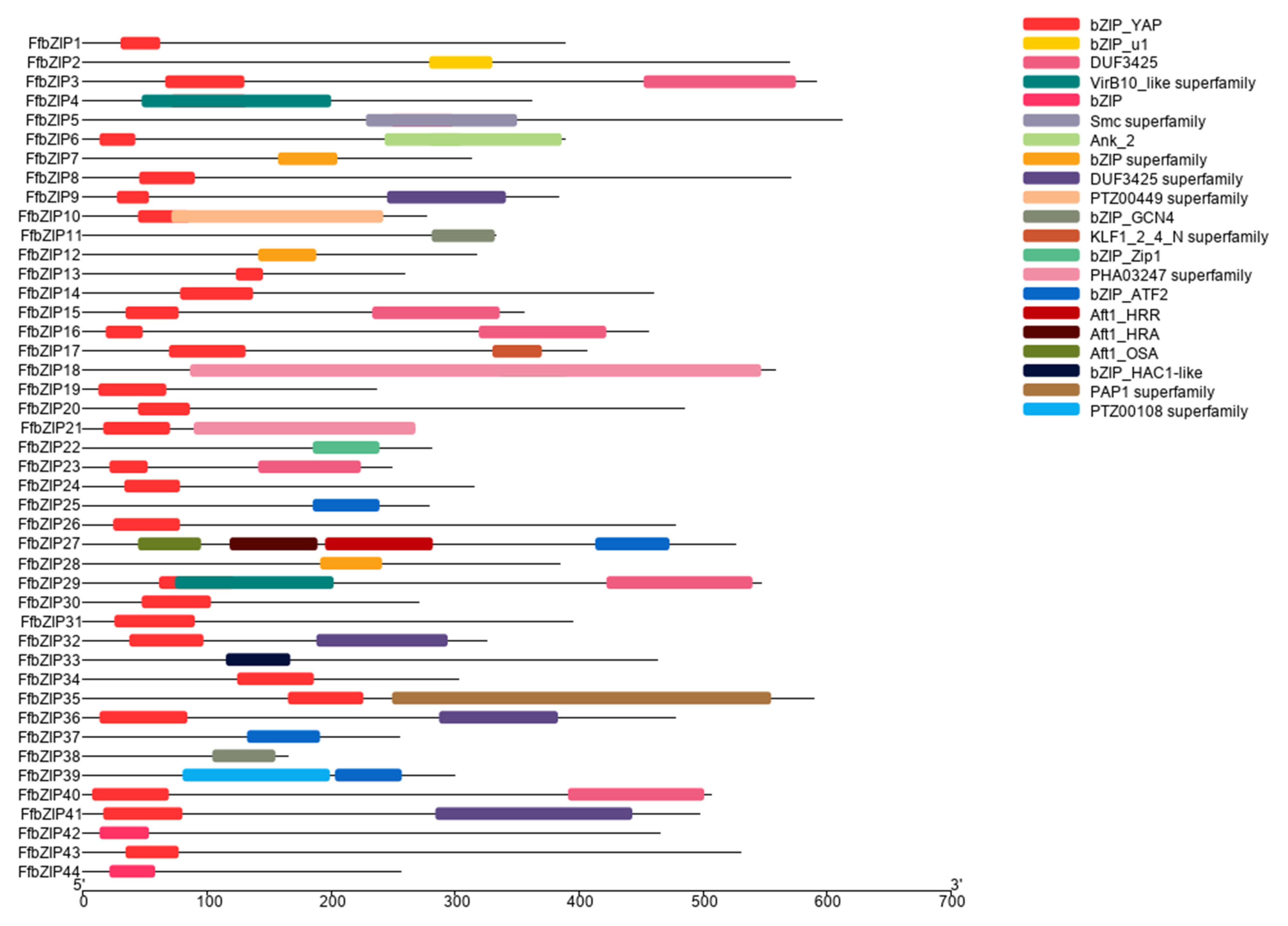
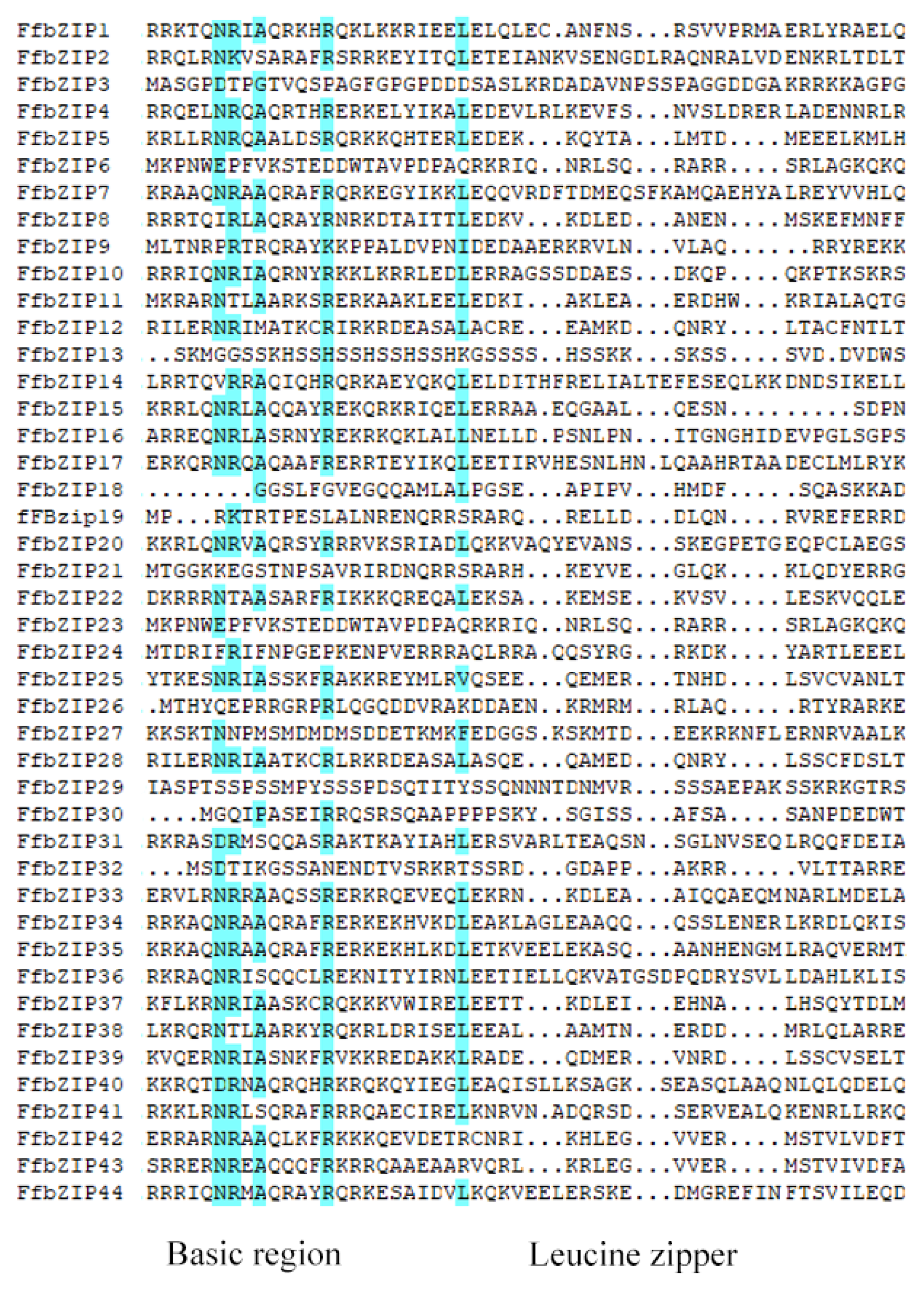
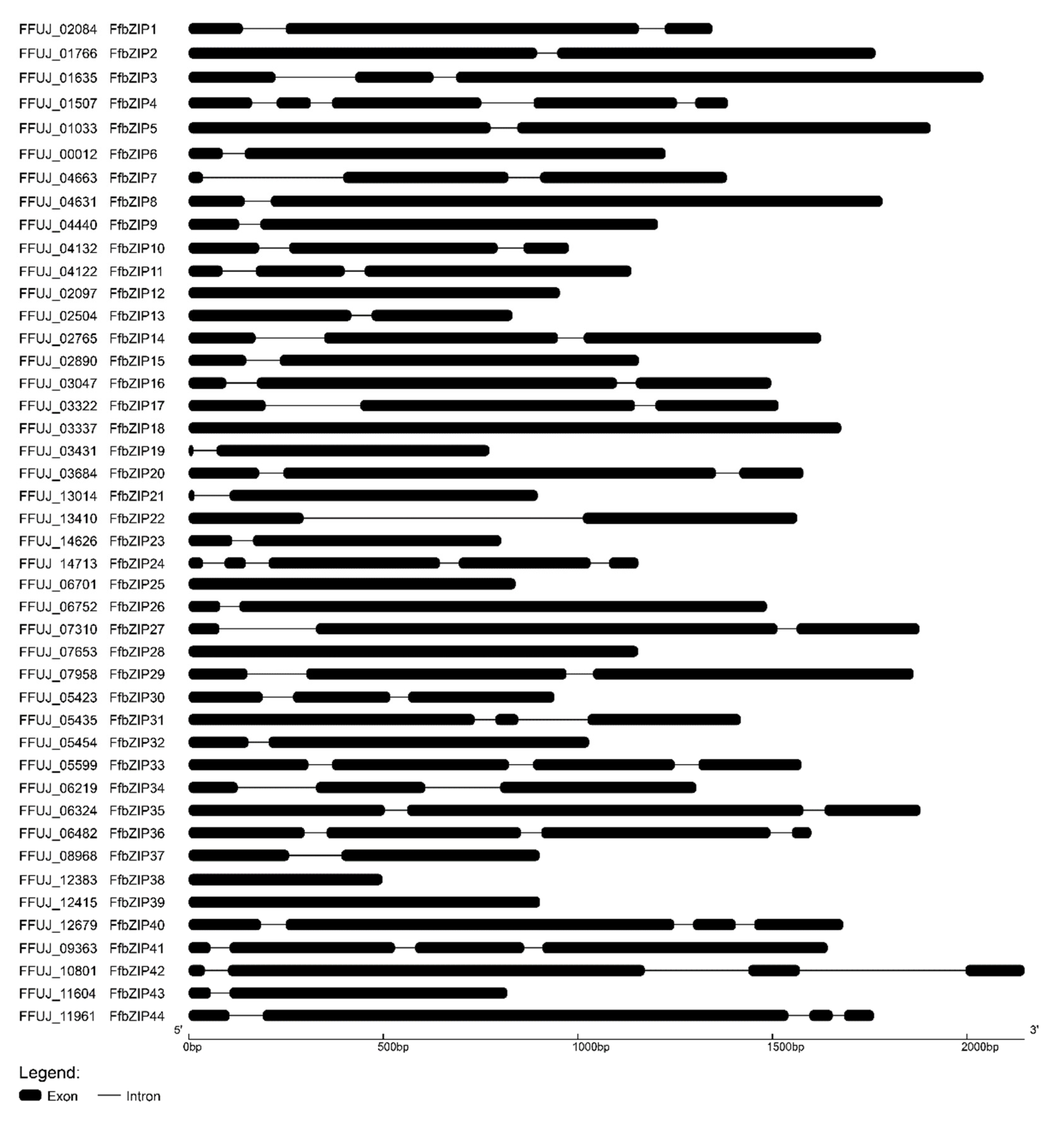
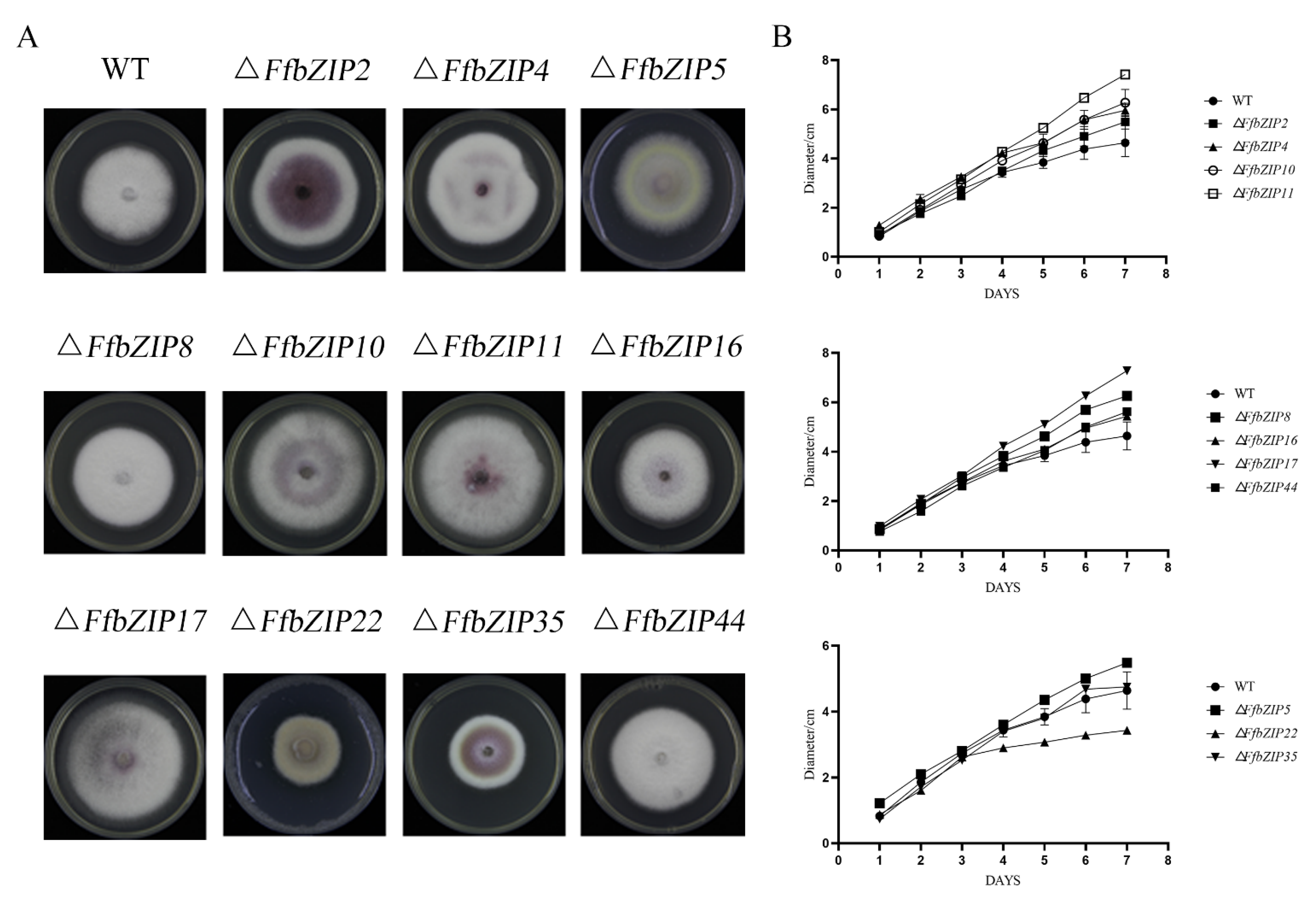
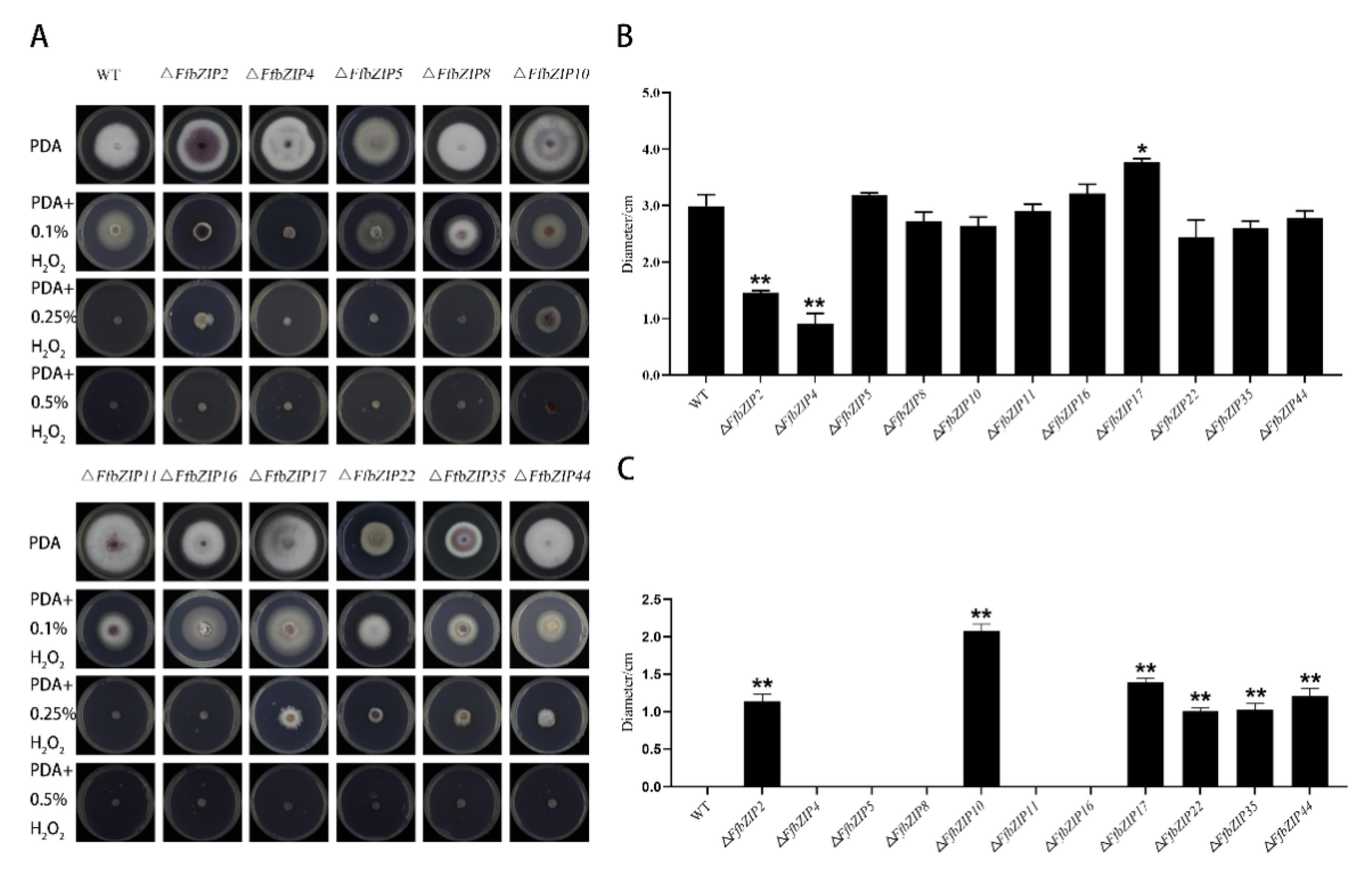

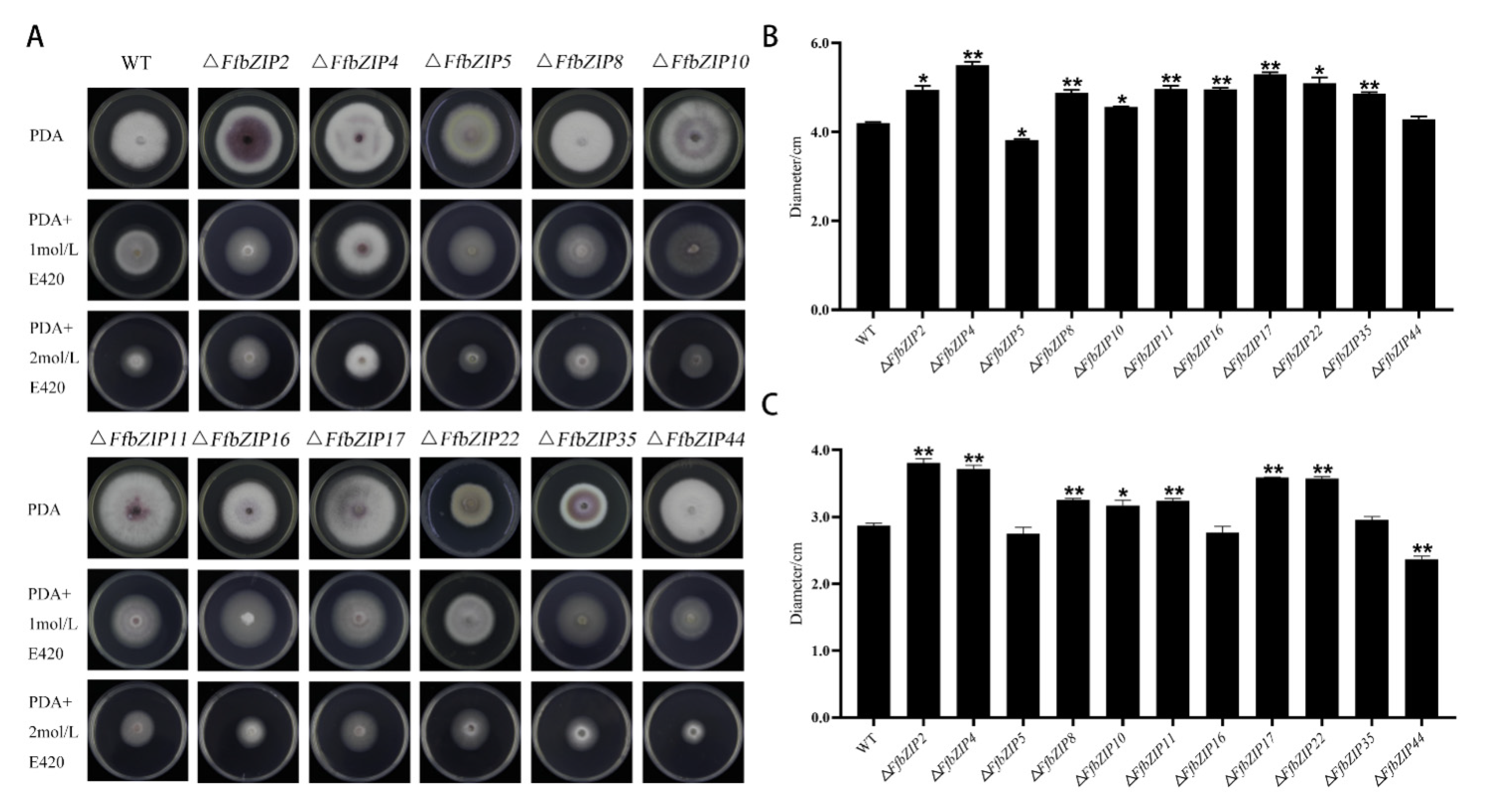
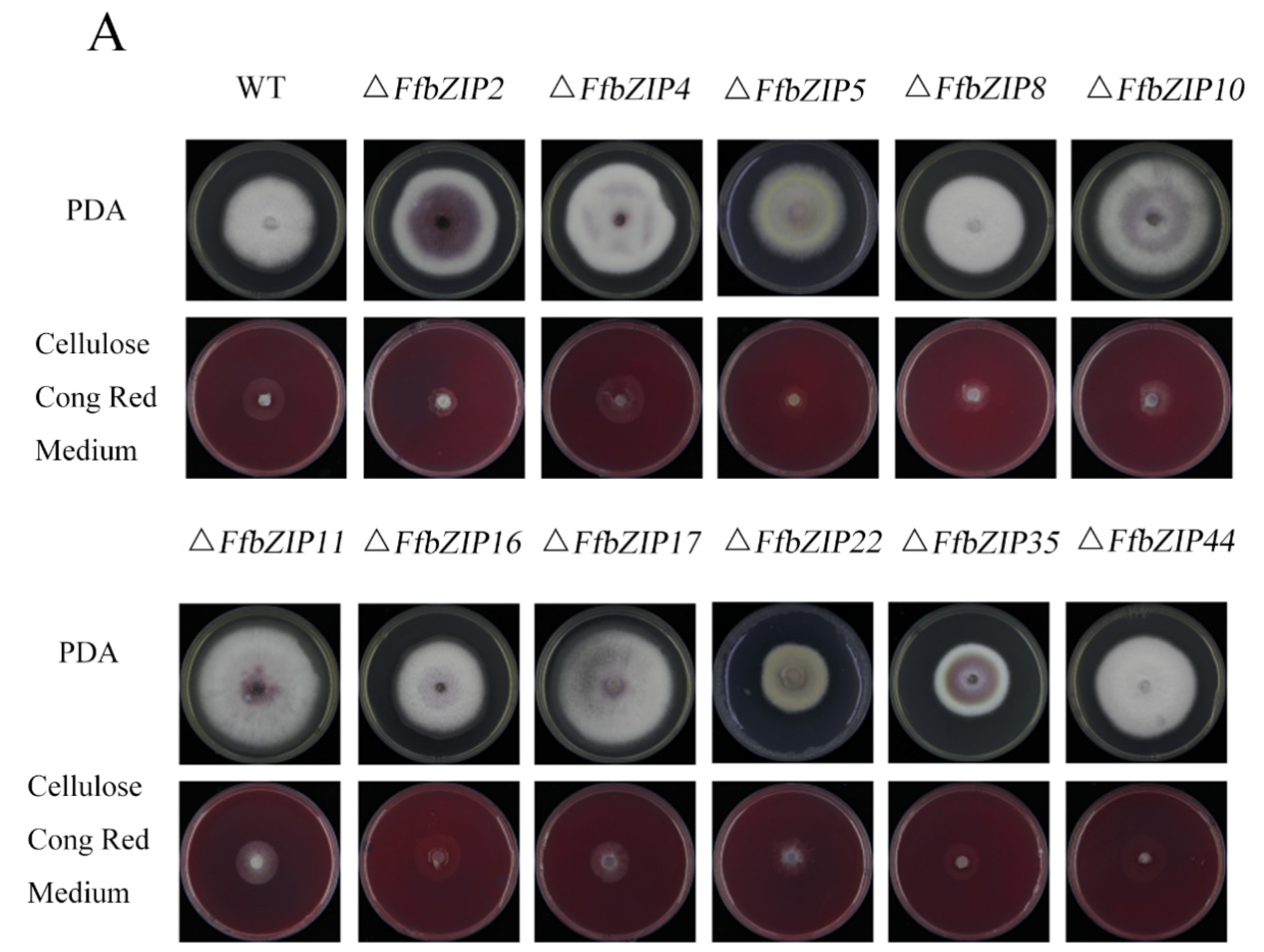
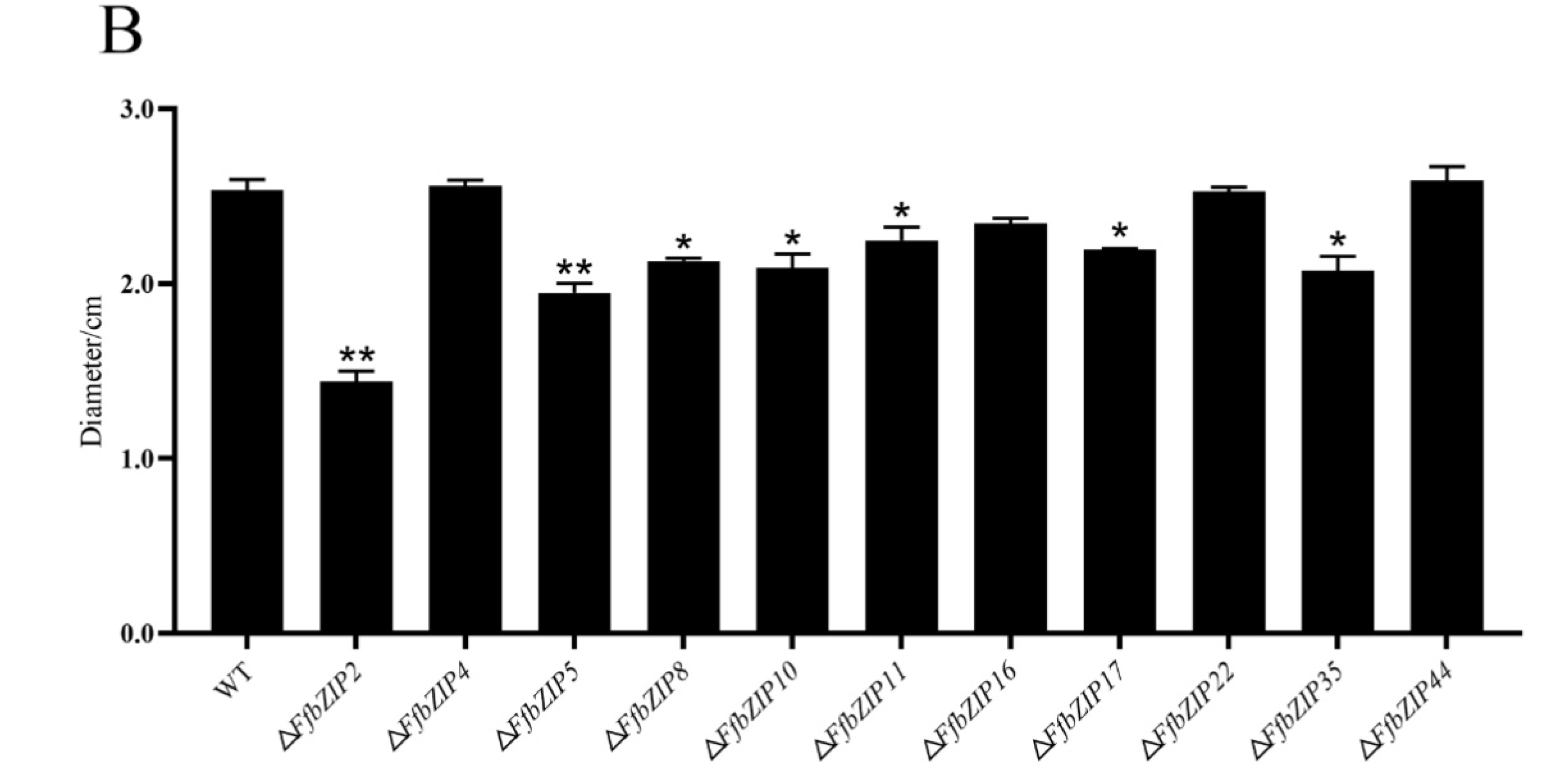
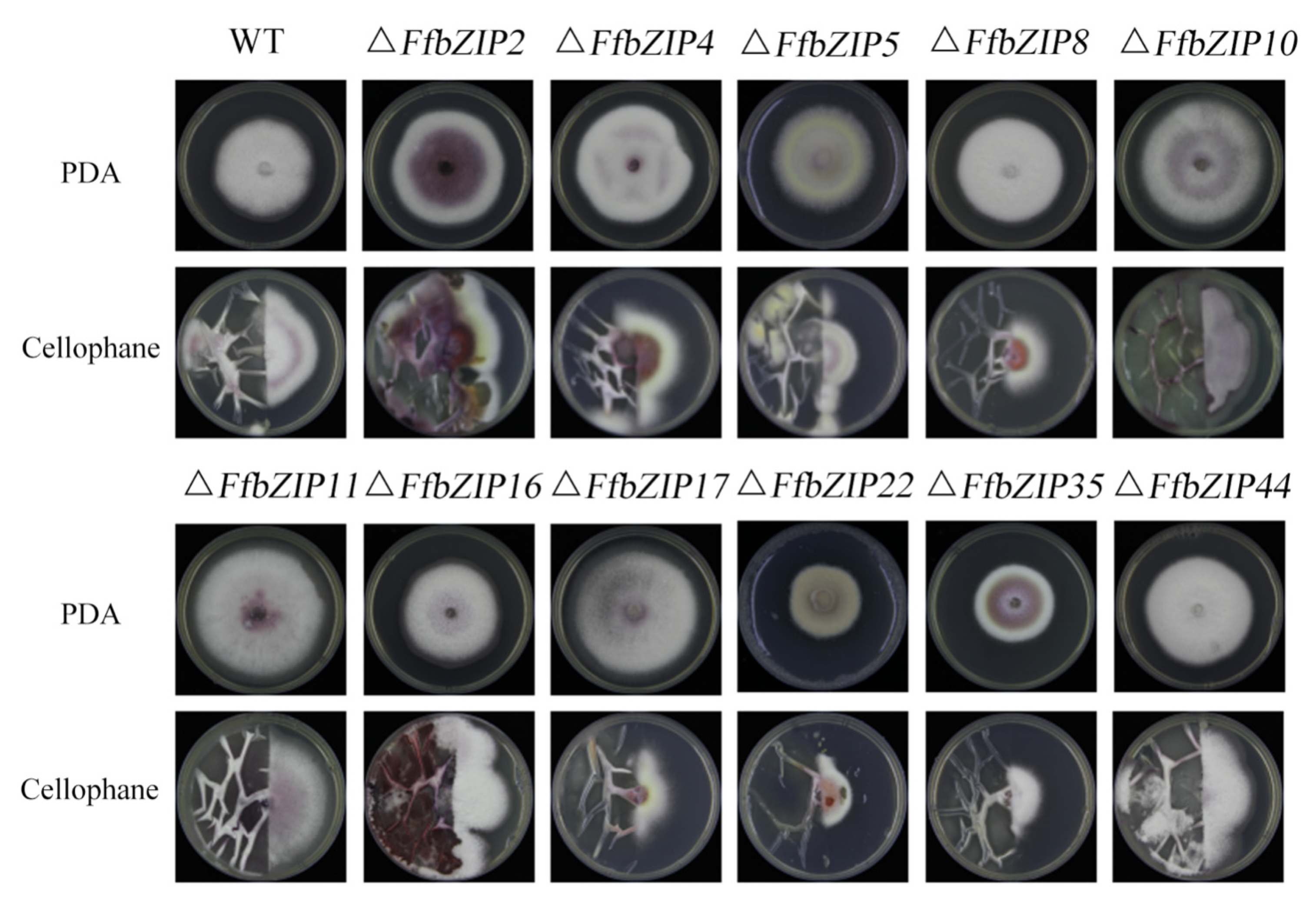
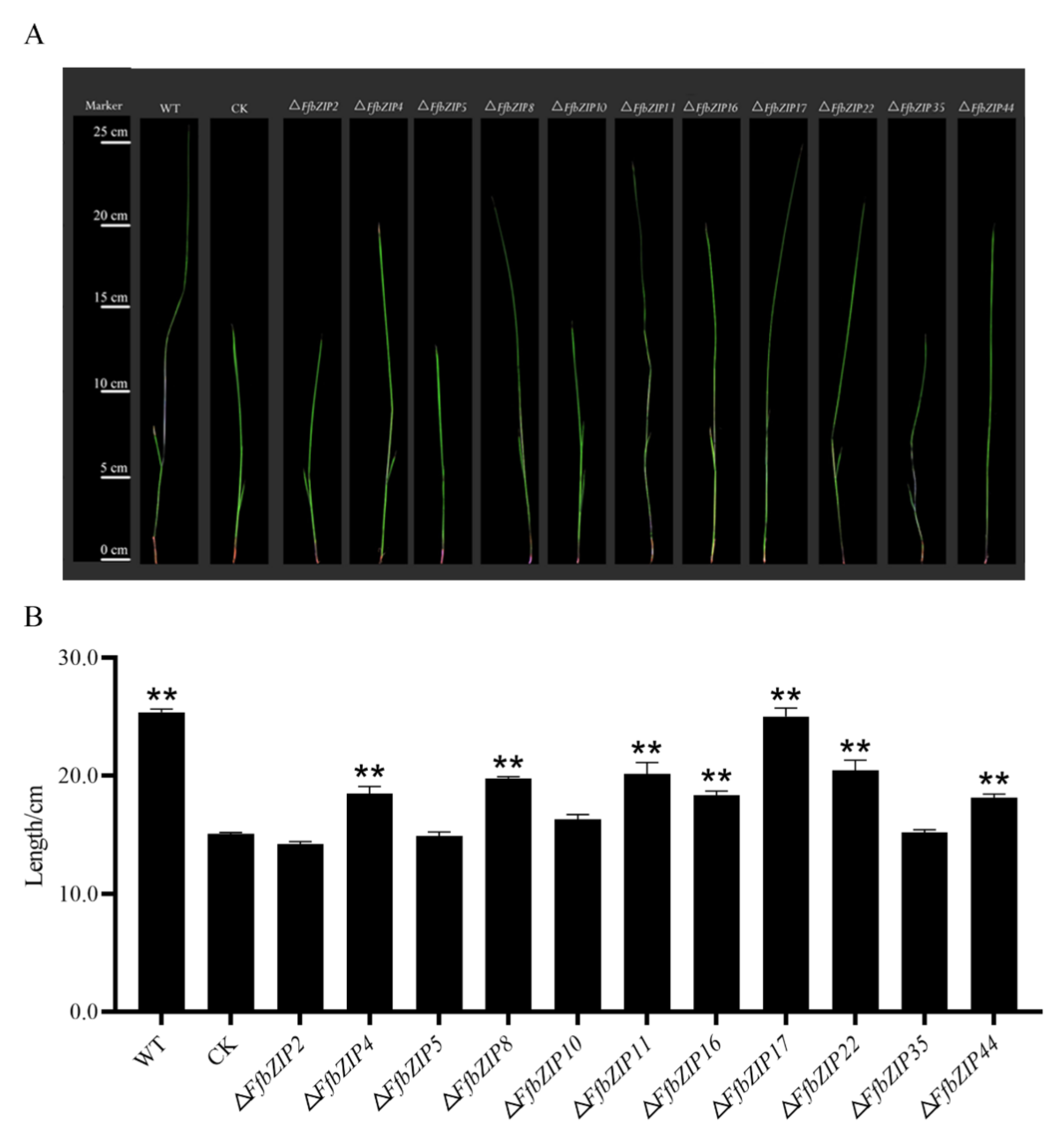
| Gene Name | Locus | Gene Symbol | Gene ID | Chromosome | Location | Protein (aa) | ORF (bp) |
|---|---|---|---|---|---|---|---|
| FfbZIP1 | XP_023423521.1 | FFUJ_02084 | 35395567 | chrom01 | 19507..20852 | 389 | 1170 |
| FfbZIP2 | XP_023423830.1 | FFUJ_01766 | 35395250 | chrom01 | 994959..996723 | 570 | 1713 |
| FfbZIP3 | XP_023423951.1 | FFUJ_01635 | 35395120 | chrom01 | 1400129..1402170 | 592 | 1779 |
| FfbZIP4 | XP_023425446.1 | FFUJ_01507 | 35394992 | chrom01 | 1910261..1911646 | 362 | 1089 |
| FfbZIP5 | XP_023424500.1 | FFUJ_01033 | 35394518 | chrom01 | 3500633..3502539 | 612 | 1839 |
| FfbZIP6 | XP_023425433.1 | FFUJ_00012 | 35393497 | chrom01 | 6509845..6511070 | 389 | 1170 |
| FfbZIP7 | XP_023426226.1 | FFUJ_04663 | 35398144 | chrom02 | 2022715..2024097 | 313 | 942 |
| FfbZIP8 | XP_023426254.1 | FFUJ_04631 | 35398112 | chrom02 | 2122298..2124080 | 571 | 1716 |
| FfbZIP9 | XP_023427120.1 | FFUJ_04440 | 35397921 | chrom02 | 2838516..2839721 | 383 | 1152 |
| FfbZIP10 | XP_023426709.1 | FFUJ_04132 | 35397613 | chrom02 | 3893261..3894237 | 277 | 834 |
| FfbZIP11 | XP_023426718.1 | FFUJ_04122 | 35397603 | chrom02 | 3926173..3927310 | 333 | 1002 |
| FfbZIP12 | XP_023427258.1 | FFUJ_02097 | 35395580 | chrom03 | 34849..35802 | 317 | 954 |
| FfbZIP13 | XP_023427633.1 | FFUJ_02504 | 35395986 | chrom03 | 1197966..1198797 | 259 | 780 |
| FfbZIP14 | XP_023427873.1 | FFUJ_02765 | 35396247 | chrom03 | 2066960..2068584 | 460 | 1383 |
| FfbZIP15 | XP_023427987.1 | FFUJ_02890 | 35396372 | chrom03 | 2501702..2502858 | 356 | 1071 |
| FfbZIP16 | XP_023428133.1 | FFUJ_03047 | 35396529 | chrom03 | 3055572..3057068 | 456 | 1371 |
| FfbZIP17 | XP_023428386.1 | FFUJ_03322 | 35396804 | chrom03 | 3964224..3965739 | 406 | 1221 |
| FfbZIP18 | XP_023428399.1 | FFUJ_03337 | 35396819 | chrom03 | 4023514..4025190 | 558 | 1677 |
| FfbZIP19 | XP_023428821.1 | FFUJ_03431 | 35396913 | chrom03 | 4359051..4359823 | 237 | 714 |
| FfbZIP20 | XP_023428723.1 | FFUJ_03684 | 35397165 | chrom03 | 4988201..4989780 | 485 | 1485 |
| FfbZIP21 | XP_023429592.1 | FFUJ_13014 | 35406470 | chrom04 | 156410..157306 | 268 | 807 |
| FfbZIP22 | XP_023429297.1 | FFUJ_13410 | 35406864 | chrom04 | 1320310..1321873 | 281 | 846 |
| FfbZIP23 | XP_023429736.1 | FFUJ_14626 | 35408007 | chrom04 | 2666927..2667729 | 249 | 750 |
| FfbZIP24 | XP_023429799.1 | FFUJ_14713 | 35408093 | chrom04 | 2879385..2880540 | 315 | 948 |
| FfbZIP25 | XP_023430031.1 | FFUJ_06701 | 35400178 | chrom05 | 3676..4515 | 279 | 840 |
| FfbZIP26 | XP_023430081.1 | FFUJ_06752 | 35400229 | chrom05 | 130034..131519 | 478 | 1437 |
| FfbZIP27 | XP_023430603.1 | FFUJ_07310 | 35400787 | chrom05 | 1704249..1706126 | 526 | 1581 |
| FfbZIP28 | XP_023430915.1 | FFUJ_07653 | 35401130 | chrom05 | 2919638..2920792 | 384 | 1155 |
| FfbZIP29 | XP_023431104.1 | FFUJ_07958 | 35401435 | chrom05 | 3847775..3849637 | 547 | 1644 |
| FfbZIP30 | XP_023431611.1 | FFUJ_05423 | 35398902 | chrom06 | 236543..237482 | 271 | 816 |
| FfbZIP31 | XP_023431622.1 | FFUJ_05435 | 35398914 | chrom06 | 270287..271705 | 395 | 1188 |
| FfbZIP32 | XP_023431638.1 | FFUJ_05454 | 35398933 | chrom06 | 309593..310621 | 325 | 978 |
| FfbZIP33 | XP_023433931.1 | FFUJ_05599 | 35399078 | chrom06 | 747268..748842 | 255 | 768 |
| FfbZIP34 | XP_023432344.1 | FFUJ_06219 | 35399696 | chrom06 | 2879412..2880716 | 303 | 912 |
| FfbZIP35 | XP_023432438.1 | FFUJ_06324 | 35399801 | chrom06 | 3250263..3252143 | 589 | 1770 |
| FfbZIP36 | XP_023432582.1 | FFUJ_06482 | 35399959 | chrom06 | 3687836..3689435 | 478 | 1437 |
| FfbZIP37 | XP_023433931.1 | FFUJ_08968 | 35402442 | chrom07 | 478942..479843 | 255 | 768 |
| FfbZIP38 | XP_023434584.1 | FFUJ_12383 | 35405839 | chrom08 | 1819337..1819834 | 165 | 498 |
| FfbZIP39 | XP_023434615.1 | FFUJ_12415 | 35405871 | chrom08 | 1903509..1904411 | 300 | 903 |
| FfbZIP40 | XP_023434864.1 | FFUJ_12679 | 35406135 | chrom08 | 2609336..2611017 | 507 | 1524 |
| FfbZIP41 | XP_023435893.1 | FFUJ_09363 | 35402832 | chrom09 | 2512271..2513912 | 497 | 1494 |
| FfbZIP42 | XP_023436813.1 | FFUJ_10801 | 35404265 | chrom10 | 1589255..1591402 | 465 | 1398 |
| FfbZIP43 | XP_023437623.1 | FFUJ_11604 | 35405065 | chrom11 | 1056054..1056872 | 256 | 771 |
| FfbZIP44 | XP_023437959.1 | FFUJ_11961 | 35405421 | chrom11 | 1910792..1912552 | 530 | 1593 |
| Domain | Gene | Function | Reference |
|---|---|---|---|
| bZIP domain | FfbZIP5, FfbZIP7, FfbZIP12, FfbZIP28, FfbZIP42, FfbZIP43 | Regulates a diverse range of cellular processes, including cell survival, learning and memory, lipid metabolism, and cancer progression; also plays an important role in the response to stimuli or stress signals such as cytokines, genotoxins, or physiological stress | [35,36] |
| bZIP_YAP domain | FfbZIP1, FfbZIP3, FfbZIP4, FfbZIP6, FfbZIP8, FfbZIP9, FfbZIP10, FfbZIP13, FfbZIP14, FfbZIP15, FfbZIP16, FfbZIP17, FfbZIP19, FfbZIP20, FfbZIP21, FfbZIP23, FfbZIP24, FfbZIP26, FfbZIP29, FfbZIP30, FfbZIP31, FfbZIP32, FfbZIP34, FfbZIP35, FfbZIP36, FfbZIP40, FfbZIP41, FfbZIP44 | May be involved in stress response, cadmium stress response, osmotic stress response, iron metabolism and arsenic detoxification | [37] |
| Bzip_u1 domain | FfbZIP2 | uncharacterized | [38] |
| bZIP_GCN4 domain | FfbZIP11, FfbZIP38 | In amino acid-deficient cells, GCN4 is upregulated, leading to transcriptional activation of genes encoding amino acid biosynthesis enzymes | [39] |
| bZIP_Zip1 domain | FfbZIP18, FfbZIP22 | Zip1 is required for the production of key proteins involved in sulfur metabolism and also plays a role in the cadmium response | [40] |
| bZIP_ATF2 domain | FfbZIP25, FfbZIP27, FfbZIP37, FfbZIP39 | In response to stress, ATF-2 activates multiple genes, including cyclin A, cyclin D, and c-Jun. ATF-2 also plays a role in the DNA damage response independent of its transcriptional activity | [41] |
| bZIP_HAC1-like domain | FfbZIP33 | Plays a key role in the unfolded protein response (UPR) | [42] |
| VirB10 domain | FfbZIP4, FfbZIP29 | Different domains of VirB10 in Agrobacterium coordinately regulate T fimbriae formation or secretion channels | [43] |
| Smc domain | FfbZIP5 | This domain is present in chromosome segregation ATPases that regulate the cell cycle, cell division and chromosome segmentation; in vertebrates it functions to regulate genome structure during interphase and cell division | [44,45,46] |
| PTZ00449 domain | FfbZIP10 | uncharacterized | [47] |
| PTZ00108 domain | FfbZIP37 | uncharacterized | [48] |
| DUF3425 domain | FfbZIP3, FfbZIP9, FfbZIP15, FfbZIP16, FfbZIP23, FfbZIP29, FfbZIP32, FfbZIP36, FfbZIP40, FfbZIP41 | uncharacterized | [49] |
| KLF1_2_4_N domain | FfbZIP17 | Members of the KLF family can act as activators or repressors of transcription depending on the context of the cell and promoter, regulating various cellular functions such as proliferation, differentiation and apoptosis, as well as development and homeostasis of several types of tissues | [50] |
| PAP1 domain | FfbZIP35 | Regulation of antioxidant gene transcription in response to H2O2 | [51] |
| Atf1_OSA | FfbZIP27 | This domain is found in the transcription factor Aft1 which is required for a wide range of stress responses. The OSA domain has been shown to be involved in the osmotic stress response. | [52] |
| Atf1_HRA | FfbZIP27 | This domain is found in the transcription factor Aft1 which is required for a wide range of stress responses. The HRA domain is involved in meiotic recombination. It has been shown to be necessary and sufficient to activate recombination. | [52] |
| Atf1_HRR | FfbZIP27 | This domain is found in the transcription factor Aft1 which is required for a wide range of stress responses. The HRR domain is involved in meiotic recombination. It has been shown to be necessary and sufficient to repress recombination. | [52] |
| Ank_2 | FfbZIP6 | Ankyrin repeats (3 copies). | [53] |
| PHA03247 | FfbZIP18, FfbZIP21 | large tegument protein UL36; Provisional. | [54] |
| Gene | Vegetative Growth | Oxidative Stress | Osmotic Stress | Cellulose Utilization | Cell Wall Selective Pressure | Cellophane Penetration | Patablethogenicity | ||
|---|---|---|---|---|---|---|---|---|---|
| Function | |||||||||
| FfbZIP2 | \ * | − * | − | + * | − | \ | + | ||
| FfbZIP4 | \ | + | − | \ | − | \ | + | ||
| FfbZIP5 | \ | \ | + | + | + | \ | + | ||
| FfbZIP8 | − | \ | − | + | − | + | + | ||
| FfbZIP10 | − | − | − | + | − | + | + | ||
| FfbZIP11 | − | \ | − | + | − | + | + | ||
| FfbZIP16 | \ | \ | − | \ | − | \ | + | ||
| FfbZIP17 | − | − | − | + | − | + | \ | ||
| FfbZIP22 | + | − | − | \ | − | + | + | ||
| FfbZIP35 | \ | − | − | + | − | + | + | ||
| FfbZIP44 | − | − | + | \ | + | \ | + | ||
Publisher’s Note: MDPI stays neutral with regard to jurisdictional claims in published maps and institutional affiliations. |
© 2022 by the authors. Licensee MDPI, Basel, Switzerland. This article is an open access article distributed under the terms and conditions of the Creative Commons Attribution (CC BY) license (https://creativecommons.org/licenses/by/4.0/).
Share and Cite
Zhao, K.; Liu, L.; Huang, S. Genome-Wide Identification and Functional Analysis of the bZIP Transcription Factor Family in Rice Bakanae Disease Pathogen, Fusarium fujikuroi. Int. J. Mol. Sci. 2022, 23, 6658. https://doi.org/10.3390/ijms23126658
Zhao K, Liu L, Huang S. Genome-Wide Identification and Functional Analysis of the bZIP Transcription Factor Family in Rice Bakanae Disease Pathogen, Fusarium fujikuroi. International Journal of Molecular Sciences. 2022; 23(12):6658. https://doi.org/10.3390/ijms23126658
Chicago/Turabian StyleZhao, Kehan, Lianmeng Liu, and Shiwen Huang. 2022. "Genome-Wide Identification and Functional Analysis of the bZIP Transcription Factor Family in Rice Bakanae Disease Pathogen, Fusarium fujikuroi" International Journal of Molecular Sciences 23, no. 12: 6658. https://doi.org/10.3390/ijms23126658
APA StyleZhao, K., Liu, L., & Huang, S. (2022). Genome-Wide Identification and Functional Analysis of the bZIP Transcription Factor Family in Rice Bakanae Disease Pathogen, Fusarium fujikuroi. International Journal of Molecular Sciences, 23(12), 6658. https://doi.org/10.3390/ijms23126658






